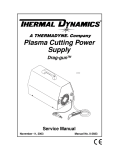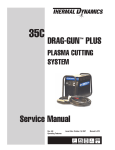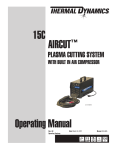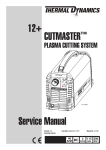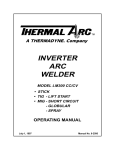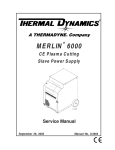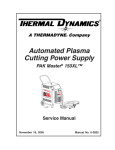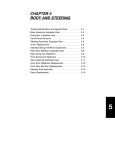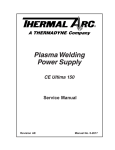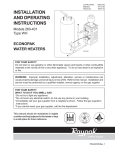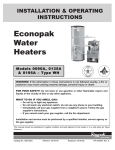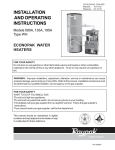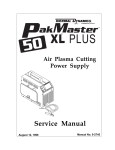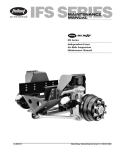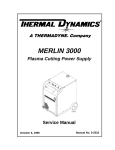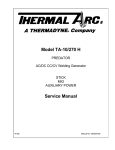Download section 1 - Victor Technologies
Transcript
ECONO-PAK 50 Air Plasma Cutting Power Supply Service Manual September 5, 1999 Manual No. 0-2671 WARNING Read and understand this entire Service Manual and your employer’s safety practices before installing, operating, or servicing the equipment. WARNING While the information contained in this Service Manual represents our best judgement, Thermal Dynamics Corporation assumes no liability for its use. Econo-Pak 50 Air Plasma Cutting Power Supply Service Manual Number 0-2671 Published by: Thermal Dynamics Corporation Industrial Park No. 2 West Lebanon, New Hampshire, USA 03784 (603) 298-5711 Copyright 1997 by Thermal Dynamics Corporation All rights reserved. Reproduction of this work, in whole or in part, without written permission of the publisher is prohibited. The publisher does not assume and hereby disclaims any liability to any party for any loss or damage caused by any error or omission in the Econo-Pak 50 Air Plasma Cutting Power Supply Service Manual, whether such error results from negligence, accident, or any other cause. Printed in the United States of America September 1999 TABLE OF CONTENTS SECTION 1: GENERAL INFORMATION .................................................................................................. 1 1.01 1.02 1.03 1.04 1.05 1.06 1.07 1.08 Notes, Cautions and Warnings ...................................................................... 1 Important Safety Precautions ........................................................................ 1 Publications ................................................................................................... 2 Note, Attention et Avertissement ................................................................... 3 Precautions De Securite Importantes ............................................................ 3 Documents De Reference ............................................................................. 5 Declaration of Conformity .............................................................................. 7 Statement of Warranty ................................................................................... 8 SECTION 2: INTRODUCTION ................................................................................................................. 9 2.01 Scope Of Manual ........................................................................................... 9 2.02 General Service Philosophy .......................................................................... 9 2.03 Service Responsibilities ................................................................................. 9 SECTION 3: DESCRIPTION .................................................................................................................. 11 3.01 Scope of Manual .......................................................................................... 11 3.02 General Description ..................................................................................... 11 3.03 Specifications/Design Features ................................................................... 11 SECTION 4: CUSTOMER/OPERATOR SERVICE .................................................................................. 13 4.01 4.02 4.03 4.04 4.05 4.06 4.07 4.08 Introduction .................................................................................................. 13 General Maintenance .................................................................................. 13 Common Operating Faults ........................................................................... 14 Troubleshooting Guides ............................................................................... 14 Basic Troubleshooting Guide ....................................................................... 14 Advanced Troubleshooting Guide ................................................................ 15 Troubleshooting Flow Charts ....................................................................... 16 Test Procedures ........................................................................................... 24 SECTION 5: REPAIRS & REPLACEMENT PROCEDURES ................................................................... 27 5.01 5.02 5.03 5.04 Introduction .................................................................................................. 27 Anti-Static Handling Procedures .................................................................. 27 Parts Replacement - General Information .................................................... 27 Power Supply Component Replacement Procedures .................................. 28 SECTION 6: PARTS LISTS ..................................................................................................................... 31 6.01 6.02 6.03 6.04 Introduction .................................................................................................. 31 Ordering Information .................................................................................... 31 Front and Rear Panel Replacement Parts List ............................................. 32 Internal Component Replacement Parts List ............................................... 34 APPENDIX I: SYSTEM SCHEMATIC ......................................................................................... 36 TABLE OF CONTENTS (continued) SECTION 1: GENERAL INFORMATION GASES AND FUMES Gases and fumes produced during the plasma cutting process can be dangerous and hazardous to your health. 1.01 Notes, Cautions and Warnings • Keep all fumes and gases from the breathing area. Keep your head out of the welding fume plume. Throughout this manual, notes, cautions, and warnings are used to highlight important information. These highlights are categorized as follows: • Use an air-supplied respirator if ventilation is not adequate to remove all fumes and gases. NOTE • The kinds of fumes and gases from the plasma arc depend on the kind of metal being used, coatings on the metal, and the different processes. You must be very careful when cutting or welding any metals which may contain one or more of the following: An operation, procedure, or background information which requires additional emphasis or is helpful in efficient operation of the system. CAUTION Antimony Arsenic Barium Beryllium Cadmium A procedure which, if not properly followed, may cause damage to the equipment. Chromium Cobalt Copper Lead Manganese Mercury Nickel Selenium Silver Vanadium • Always read the Material Safety Data Sheets (MSDS) that should be supplied with the material you are using. These MSDSs will give you the information regarding the kind and amount of fumes and gases that may be dangerous to your health. WARNING A procedure which, if not properly followed, may cause injury to the operator or others in the operating area. • For information on how to test for fumes and gases in your workplace, refer to item 1 in Subsection 1.03, Publications in this manual. 1.02 Important Safety Precautions • Use special equipment, such as water or down draft cutting tables, to capture fumes and gases. WARNINGS • Do not use the plasma torch in an area where combustible or explosive gases or materials are located. • Phosgene, a toxic gas, is generated from the vapors of chlorinated solvents and cleansers. Remove all sources of these vapors. OPERATION AND MAINTENANCE OF PLASMA ARC EQUIPMENT CAN BE DANGEROUS AND HAZARDOUS TO YOUR HEALTH. ELECTRIC SHOCK Plasma arc cutting produces intense electric and magnetic emissions that may interfere with the proper function of cardiac pacemakers, hearing aids, or other electronic health equipment. Persons who work near plasma arc cutting applications should consult their medical health professional and the manufacturer of the health equipment to determine whether a hazard exists. Electric Shock can injure or kill. The plasma arc process uses and produces high voltage electrical energy. This electric energy can cause severe or fatal shock to the operator or others in the workplace. To prevent possible injury, read, understand and follow all warnings, safety precautions and instructions before using the equipment. Call 1-603298-5711 or your local distributor if you have any questions. • Wear dry gloves and clothing. Insulate yourself from the work piece or other parts of the welding circuit. • Never touch any parts that are electrically “live” or “hot.” • Repair or replace all worn or damaged parts. • Extra care must be taken when the workplace is moist or damp. Date: 6/22/99 1 GENERAL INFORMATION • Install and maintain equipment according to NEC code, refer to item 9 in Subsection 1.03, Publications. • To protect your eyes, always wear a welding helmet or shield. Also always wear safety glasses with side shields, goggles or other protective eye wear. • Disconnect power source before performing any service or repairs. • Wear welding gloves and suitable clothing to protect your skin from the arc rays and sparks. • Read and follow all the instructions in the Operating Manual. • Keep helmet and safety glasses in good condition. Replace lenses when cracked, chipped or dirty. • Protect others in the work area from the arc rays. Use protective booths, screens or shields. FIRE AND EXPLOSION • Use the shade of lens as suggested in the following per ANSI/ASC Z49.1: Fire and explosion can be caused by hot slag, sparks, or the plasma arc. • Be sure there is no combustible or flammable material in the workplace. Any material that cannot be removed must be protected. • Ventilate all flammable or explosive vapors from the workplace. Arc Current Minimum Protective Shade No. Suggested Shade No. Less Than 300* 8 9 300 - 400* 9 12 400 - 800* 10 14 * These values apply where the actual arc is clearly seen. Experience has shown that lighter filters may be used when the arc is hidden by the workpiece. • Do not cut or weld on containers that may have held combustibles. • Provide a fire watch when working in an area where fire hazards may exist. 1.03 Publications • Hydrogen gas may be formed and trapped under aluminum workpieces when they are cut underwater or while using a water table. DO NOT cut aluminum alloys underwater or on a water table unless the hydrogen gas can be eliminated or dissipated. Trapped hydrogen gas that is ignited will cause an explosion. Refer to the following standards or their latest revisions for more information: 1. OSHA, SAFETY AND HEALTH STANDARDS, 29CFR 1910, obtainable from the Superintendent of Documents, U.S. Government Printing Office, Washington, D.C. 20402 2. ANSI Standard Z49.1, SAFETY IN WELDING AND CUTTING, obtainable from the American Welding Society, 550 N.W. LeJeune Rd, Miami, FL 33126 NOISE Noise can cause permanent hearing loss. Plasma arc processes can cause noise levels to exceed safe limits. You must protect your ears from loud noise to prevent permanent loss of hearing. 3. NIOSH, SAFETY AND HEALTH IN ARC WELDING AND GAS WELDING AND CUTTING, obtainable from the Superintendent of Documents, U.S. Government Printing Office, Washington, D.C. 20402 • To protect your hearing from loud noise, wear protective ear plugs and/or ear muffs. Protect others in the workplace. 4. ANSI Standard Z87.1, SAFE PRACTICES FOR OCCUPATION AND EDUCATIONAL EYE AND FACE PROTECTION, obtainable from American National Standards Institute, 1430 Broadway, New York, NY 10018 • Noise levels should be measured to be sure the decibels (sound) do not exceed safe levels. 5. ANSI Standard Z41.1, STANDARD FOR MEN’S SAFETY-TOE FOOTWEAR, obtainable from the American National Standards Institute, 1430 Broadway, New York, NY 10018 • For information on how to test for noise, see item 1 in Subsection 1.03, Publications, in this manual. 6. ANSI Standard Z49.2, FIRE PREVENTION IN THE USE OF CUTTING AND WELDING PROCESSES, obtainable from American National Standards Institute, 1430 Broadway, New York, NY 10018 PLASMA ARC RAYS Plasma Arc Rays can injure your eyes and burn your skin. The plasma arc process produces very bright ultra violet and infra red light. These arc rays will damage your eyes and burn your skin if you are not properly protected. GENERAL INFORMATION 7. AWS Standard A6.0, WELDING AND CUTTING CONTAINERS WHICH HAVE HELD COMBUSTIBLES, obtainable from American Welding Society, 550 N.W. LeJeune Rd, Miami, FL 33126 2 Date 6/22/99 8. NFPA Standard 51, OXYGEN-FUEL GAS SYSTEMS FOR WELDING, CUTTING AND ALLIED PROCESSES, obtainable from the National Fire Protection Association, Batterymarch Park, Quincy, MA 02269 AVERTISSEMENT 9. NFPA Standard 70, NATIONAL ELECTRICAL CODE, obtainable from the National Fire Protection Association, Batterymarch Park, Quincy, MA 02269 Toute procédure pouvant provoquer des blessures de l’opérateur ou des autres personnes se trouvant dans la zone de travail en cas de non-respect de la procédure en question. 10. NFPA Standard 51B, CUTTING AND WELDING PROCESSES, obtainable from the National Fire Protection Association, Batterymarch Park, Quincy, MA 02269 1.05 Precautions De Securite Importantes 11. CGA Pamphlet P-1, SAFE HANDLING OF COMPRESSED GASES IN CYLINDERS, obtainable from the Compressed Gas Association, 1235 Jefferson Davis Highway, Suite 501, Arlington, VA 22202 AVERTISSEMENTS 12. CSA Standard W117.2, CODE FOR SAFETY IN WELDING AND CUTTING, obtainable from the Canadian Standards Association, Standards Sales, 178 Rexdale Boulevard, Rexdale, Ontario, Canada M9W 1R3 L’OPÉRATION ET LA MAINTENANCE DU MATÉRIEL DE SOUDAGE À L’ARC AU JET DE PLASMA PEUVENT PRÉSENTER DES RISQUES ET DES DANGERS DE SANTÉ. 13. NWSA booklet, WELDING SAFETY BIBLIOGRAPHY obtainable from the National Welding Supply Association, 1900 Arch Street, Philadelphia, PA 19103 Coupant à l’arc au jet de plasma produit de l’énergie électrique haute tension et des émissions magnétique qui peuvent interférer la fonction propre d’un “pacemaker” cardiaque, les appareils auditif, ou autre matériel de santé electronique. Ceux qui travail près d’une application à l’arc au jet de plasma devrait consulter leur membre professionel de médication et le manufacturier de matériel de santé pour déterminer s’il existe des risques de santé. 14. American Welding Society Standard AWSF4.1, RECOMMENDED SAFE PRACTICES FOR THE PREPARATION FOR WELDING AND CUTTING OF CONTAINERS AND PIPING THAT HAVE HELD HAZARDOUS SUBSTANCES, obtainable from the American Welding Society, 550 N.W. LeJeune Rd, Miami, FL 33126 15. ANSI Standard Z88.2, PRACTICE FOR RESPIRATORY PROTECTION, obtainable from American National Standards Institute, 1430 Broadway, New York, NY 10018 Il faut communiquer aux opérateurs et au personnel TOUS les dangers possibles. Afin d’éviter les blessures possibles, lisez, comprenez et suivez tous les avertissements, toutes les précautions de sécurité et toutes les consignes avant d’utiliser le matériel. Composez le + 603-298-5711 ou votre distributeur local si vous avez des questions. 1.04 Note, Attention et Avertissement Dans ce manuel, les mots “note,” “attention,” et “avertissement” sont utilisés pour mettre en relief des informations à caractère important. Ces mises en relief sont classifiées comme suit : FUMÉE et GAZ NOTE La fumée et les gaz produits par le procédé de jet de plasma peuvent présenter des risques et des dangers de santé. Toute opération, procédure ou renseignement général sur lequel il importe d’insister davantage ou qui contribue à l’efficacité de fonctionnement du système. • Eloignez toute fumée et gaz de votre zone de respiration. Gardez votre tête hors de la plume de fumée provenant du chalumeau. ATTENTION • Utilisez un appareil respiratoire à alimentation en air si l’aération fournie ne permet pas d’éliminer la fumée et les gaz. Toute procédure pouvant résulter l’endommagement du matériel en cas de nonrespect de la procédure en question. Date: 6/22/99 3 GENERAL INFORMATION • Les sortes de gaz et de fumée provenant de l’arc de plasma dépendent du genre de métal utilisé, des revêtements se trouvant sur le métal et des différents procédés. Vous devez prendre soin lorsque vous coupez ou soudez tout métal pouvant contenir un ou plusieurs des éléments suivants: antimoine cadmium mercure argent chrome nickel arsenic cobalt plomb baryum cuivre sélénium béryllium manganèse vanadium INCENDIE ET EXPLOSION Les incendies et les explosions peuvent résulter des scories chaudes, des étincelles ou de l’arc de plasma. Le procédé à l’arc de plasma produit du métal, des étincelles, des scories chaudes pouvant mettre le feu aux matières combustibles ou provoquer l’explosion de fumées inflammables. • Soyez certain qu’aucune matière combustible ou inflammable ne se trouve sur le lieu de travail. Protégez toute telle matière qu’il est impossible de retirer de la zone de travail. • Lisez toujours les fiches de données sur la sécurité des matières (sigle américain “MSDS”); celles-ci devraient être fournies avec le matériel que vous utilisez. Les MSDS contiennent des renseignements quant à la quantité et la nature de la fumée et des gaz pouvant poser des dangers de santé. • Procurez une bonne aération de toutes les fumées inflammables ou explosives. • Ne coupez pas et ne soudez pas les conteneurs ayant pu renfermer des matières combustibles. • Pour des informations sur la manière de tester la fumée et les gaz de votre lieu de travail, consultez l’article 1 et les documents cités à la page 5. • Prévoyez une veille d’incendie lors de tout travail dans une zone présentant des dangers d’incendie. • Utilisez un équipement spécial tel que des tables de coupe à débit d’eau ou à courant descendant pour capter la fumée et les gaz. • Le gas hydrogène peut se former ou s’accumuler sous les pièces de travail en aluminium lorsqu’elles sont coupées sous l’eau ou sur une table d’eau. NE PAS couper les alliages en aluminium sous l’eau ou sur une table d’eau à moins que le gas hydrogène peut s’échapper ou se dissiper. Le gas hydrogène accumulé explosera si enflammé. • N’utilisez pas le chalumeau au jet de plasma dans une zone où se trouvent des matières ou des gaz combustibles ou explosifs. • Le phosgène, un gaz toxique, est généré par la fumée provenant des solvants et des produits de nettoyage chlorés. Eliminez toute source de telle fumée. RAYONS D’ARC DE PLASMA CHOC ELECTRIQUE Les rayons provenant de l’arc de plasma peuvent blesser vos yeux et brûler votre peau. Le procédé à l’arc de plasma produit une lumière infra-rouge et des rayons ultra-violets très forts. Ces rayons d’arc nuiront à vos yeux et brûleront votre peau si vous ne vous protégez pas correctement. Les chocs électriques peuvent blesser ou même tuer. Le procédé au jet de plasma requiert et produit de l’énergie électrique haute tension. Cette énergie électrique peut produire des chocs graves, voire mortels, pour l’opérateur et les autres personnes sur le lieu de travail. • Pour protéger vos yeux, portez toujours un casque ou un écran de soudeur. Portez toujours des lunettes de sécurité munies de parois latérales ou des lunettes de protection ou une autre sorte de protection oculaire. • Ne touchez jamais une pièce “sous tension” ou “vive”; portez des gants et des vêtements secs. Isolez-vous de la pièce de travail ou des autres parties du circuit de soudage. • Portez des gants de soudeur et un vêtement protecteur approprié pour protéger votre peau contre les étincelles et les rayons de l’arc. • Réparez ou remplacez toute pièce usée ou endommagée. • Prenez des soins particuliers lorsque la zone de travail est humide ou moite. • Maintenez votre casque et vos lunettes de protection en bon état. Remplacez toute lentille sale ou comportant fissure ou rognure. • Montez et maintenez le matériel conformément au Code électrique national des Etats-Unis. (Voir la page 5, article 9.) • Protégez les autres personnes se trouvant sur la zone de travail contre les rayons de l’arc en fournissant des cabines ou des écrans de protection. • Débranchez l’alimentation électrique avant tout travail d’entretien ou de réparation. • Lisez et respectez toutes les consignes du Manuel de consignes. GENERAL INFORMATION 4 Date 6/22/99 • Utilisez la nuance de lentille qui est suggèrée dans le recommendation qui suivent ANSI/ASC Z49.1: Courant Arc Nuance Minimum Protective Numéro Nuance Suggerée Numéro Moins de 300* 8 9 300 - 400* 9 12 400 - 800* 10 14 4. Norme ANSI Z87.1, PRATIQUES SURES POUR LA PROTECTION DES YEUX ET DU VISAGE AU TRAVAIL ET DANS LES ECOLES, disponible de l’Institut Américain des Normes Nationales (American National Standards Institute), 1430 Broadway, New York, NY 10018 * Ces valeurs s’appliquent ou l’arc actuel est observé clairement. L’experience a démontrer que les filtres moins foncés peuvent être utilisés quand l’arc est caché par moiceau de travail. BRUIT 5. Norme ANSI Z41.1, NORMES POUR LES CHAUSSURES PROTECTRICES, disponible auprès de l’American National Standards Institute, 1430 Broadway, New York, NY 10018 6. Norme ANSI Z49.2, PRÉVENTION DES INCENDIES LORS DE L’EMPLOI DE PROCÉDÉS DE COUPE ET DE SOUDAGE, disponible auprès de l’American National Standards Institute, 1430 Broadway, New York, NY 10018 7. Norme A6.0 de l’Association Américaine du Soudage (AWS), LE SOUDAGE ET LA COUPE DE CONTENEURS AYANT RENFERMÉ DES PRODUITS COMBUSTIBLES, disponible auprès de la American Welding Society, 550 N.W. LeJeune Rd., Miami, FL 33126 Le bruit peut provoquer une perte permanente de l’ouïe. Les procédés de soudage à l’arc de plasma peuvent provoquer des niveaux sonores supérieurs aux limites normalement acceptables. Vous dú4ez vous protéger les oreilles contre les bruits forts afin d’éviter une perte permanente de l’ouïe. 8. Norme 51 de l’Association Américaine pour la Protection contre les Incendies (NFPA), LES SYSTEMES À GAZ AVEC ALIMENTATION EN OXYGENE POUR LE SOUDAGE, LA COUPE ET LES PROCÉDÉS ASSOCIÉS, disponible auprès de la National Fire Protection Association, Batterymarch Park, Quincy, MA 02269 • Pour protéger votre ouïe contre les bruits forts, portez des tampons protecteurs et/ou des protections auriculaires. Protégez également les autres personnes se trouvant sur le lieu de travail. • Il faut mesurer les niveaux sonores afin d’assurer que les décibels (le bruit) ne dépassent pas les niveaux sûrs. 9. Norme 70 de la NFPA, CODE ELECTRIQUE NATIONAL, disponible auprès de la National Fire Protection Association, Batterymarch Park, Quincy, MA 02269 • Pour des renseignements sur la manière de tester le bruit, consultez l’article 1, page 5. 1.06 Documents De Reference 10. Norme 51B de la NFPA, LES PROCÉDÉS DE COUPE ET DE SOUDAGE, disponible auprès de la National Fire Protection Association, Batterymarch Park, Quincy, MA 02269 Consultez les normes suivantes ou les révisions les plus récentes ayant été faites à celles-ci pour de plus amples renseignements : 1. OSHA, NORMES DE SÉCURITÉ DU TRAVAIL ET DE PROTECTION DE LA SANTÉ, 29CFR 1910, disponible auprès du Superintendent of Documents, U.S. Government Printing Office, Washington, D.C. 20402 11. Brochure GCA P-1, LA MANIPULATION SANS RISQUE DES GAZ COMPRIMÉS EN CYLINDRES, disponible auprès de l’Association des Gaz Comprimés (Compressed Gas Association), 1235 Jefferson Davis Highway, Suite 501, Arlington, VA 22202 2. Norme ANSI Z49.1, LA SÉCURITÉ DES OPÉRATIONS DE COUPE ET DE SOUDAGE, disponible auprès de la Société Américaine de Soudage (American Welding Society), 550 N.W. LeJeune Rd., Miami, FL 33126 12. Norme CSA W117.2, CODE DE SÉCURITÉ POUR LE SOUDAGE ET LA COUPE, disponible auprès de l’Association des Normes Canadiennes, Standards Sales, 178 Rexdale Boulevard, Rexdale, Ontario, Canada, M9W 1R3 3. NIOSH, LA SÉCURITÉ ET LA SANTÉ LORS DES OPÉRATIONS DE COUPE ET DE SOUDAGE À L’ARC ET AU GAZ, disponible auprès du Superintendent of Documents, U.S. Government Printing Office, Washington, D.C. 20402 13. ivret NWSA, BIBLIOGRAPHIE SUR LA SÉCURITÉ DU SOUDAGE, disponible auprès de l’Association Nationale de Fournitures de Soudage (National Welding Supply Association), 1900 Arch Street, Philadelphia, PA 19103 Date: 6/22/99 5 GENERAL INFORMATION 14. Norme AWSF4.1 de l’Association Américaine de Soudage, RECOMMANDATIONS DE PRATIQUES SURES POUR LA PRÉPARATION À LA COUPE ET AU SOUDAGE DE CONTENEURS ET TUYAUX AYANT RENFERMÉ DES PRODUITS DANGEREUX , disponible auprès de la American Welding Society, 550 N.W. LeJeune Rd., Miami, FL 33126 15. Norme ANSI Z88.2, PRATIQUES DE PROTECTION RESPIRATOIRE, disponible auprès de l’American National Standards Institute, 1430 Broadway, New York, NY 10018 GENERAL INFORMATION 6 Date 6/22/99 1.07 Declaration of Conformity Manufacturer: Thermal Dynamics Corporation Address: Industrial Park #2 West Lebanon, New Hampshire 03784 USA The equipment described in this manual conforms to all applicable aspects and regulations of the ‘Low Voltage Directive’ (European Council Directive 73/23/EEC as amended by Council Directive 93/68/EEC) and to the National legislation for the enforcement of this Directive. Serial numbers are unique with each individual piece of equipment and details description, parts used to manufacture a unit and date of manufacture. National Standard and Technical Specifications The product is designed and manufactured to a number of standards and technical requirements among them are: * CSA (Canadian Standards Association) standard C22.2 number 60 for Arc welding equipment. * UL (Underwriters Laboratory) rating 94VO flammability testing for all printed-circuit boards used. * ISO/IEC 60974-1 (BS 638-PT10) (EN 60 974-1) (EN50192) (EN50078) applicable to plasma cutting equipment and associated accessories. * Extensive product design verification is conducted at the manufacturing facility as part of the routine design and manufacturing process. This is to ensure the product is safe, when used according to instructions in this manual and related industry standards, and performs as specified. Rigorous testing is incorporated into the manufacturing process to ensure the manufactured product meets or exceeds all design specifications. Thermal Dynamics has been manufacturing products for more than 30 years, and will continue to achieve excellence in our area of manufacture. Manufacturers responsible representative: Date: 6/22/99 Steve Ward Director of Operations Thermadyne UK Chorley England 7 GENERAL INFORMATION 1.08 Statement of Warranty LIMITED WARRANTY: Thermal Dynamics® Corporation (hereinafter “Thermal”) warrants that its products will be free of defects in workmanship or material. Should any failure to conform to this warranty appear within the time period applicable to the Thermal products as stated below, Thermal shall, upon notification thereof and substantiation that the product has been stored, installed, operated, and maintained in accordance with Thermal’s specifications, instructions, recommendations and recognized standard industry practice, and not subject to misuse, repair, neglect, alteration, or accident, correct such defects by suitable repair or replacement, at Thermal’s sole option, of any components or parts of the product determined by Thermal to be defective. THIS WARRANTY IS EXCLUSIVE AND IS IN LIEU OF ANY WARRANTY OF MERCHANTABILITY OR FITNESS FOR A PARTICULAR PURPOSE. LIMITATION OF LIABILITY: Thermal shall not under any circumstances be liable for special or consequential damages, such as, but not limited to, damage or loss of purchased or replacement goods, or claims of customers of distributor (hereinafter “Purchaser”) for service interruption. The remedies of the Purchaser set forth herein are exclusive and the liability of Thermal with respect to any contract, or anything done in connection therewith such as the performance or breach thereof, or from the manufacture, sale, delivery, resale, or use of any goods covered by or furnished by Thermal whether arising out of contract, negligence, strict tort, or under any warranty, or otherwise, shall not, except as expressly provided herein, exceed the price of the goods upon which such liability is based. THIS WARRANTY BECOMES INVALID IF REPLACEMENT PARTS OR ACCESSORIES ARE USED WHICH MAY IMPAIR THE SAFETY OR PERFORMANCE OF ANY THERMAL PRODUCT. THIS WARRANTY IS INVALID IF THE PRODUCT IS SOLD BY NON-AUTHORIZED PERSONS. The limited warranty periods for Thermal products shall be as follows (with the exception of XL Plus Series, CutMaster 80XL , Cougar and DRAG-GUN): A maximum of three (3) years from date of sale to an authorized distributor and a maximum of two (2) years from date of sale by such distributor to the Purchaser, and with the further limitations on such two (2) year period (see chart below). The limited warranty period for XL Plus Series and CutMaster 80XL shall be as follows: A maximum of four (4) years from date of sale to an authorized distributor and a maximum of three (3) years from date of sale by such distributor to the Purchaser, and with the further limitations on such three (3) year period (see chart below). The limited warranty period for Cougar and DRAG-GUN shall be as follows: A maximum of two (2) years from date of sale to an authorized distributor and a maximum of one (1) year from date of sale by such distributor to the Purchaser, and with the further limitations on such two (2) year period (see chart below). Parts PAK Units, Power Supplies XL Plus Series & CutMaster 80XL Parts Cougar/Drag-Gun Parts All Others Labor Main Power Magnetics 3 Years 1 Year 2 Years 1 Year Original Main Power Rectifier 3 Years 1 Year 2 Years 1 Year Control PC Board 3 Years 1 Year 2 Years 1 Year All Other Circuits And Components Including, But Not Limited To, Starting Circuit, Contactors, Relays, Solenoids, Pumps, Power Switching Semi-Conductors 1 Year 1 Year 1 Year 1 Year 1 Year 1 Year 1 Year 1 Year Consoles, Control Equipment, Heat Exchanges, And Accessory Equipment 1 Year Torch And Leads Maximizer 300 Torch All Other Torches Repair/Replacement Parts 180 Days 180 Days 180 Days 180 Days 90 Days 90 Days 90 Days None Warranty repairs or replacement claims under this limited warranty must be submitted by an authorized Thermal Dynamics® repair facility within thirty (30) days of the repair. No transportation costs of any kind will be paid under this warranty. Transportation charges to send products to an authorized warranty repair facility shall be the responsibility of the customer. All returned goods shall be at the customer’s risk and expense. This warranty supersedes all previous Thermal warranties. Effective May 6, 1999 GENERAL INFORMATION 8 Date 6/22/99 SECTION 2: INTRODUCTION 2.01 Scope Of Manual This Manual provides Service Instructions for Thermal Dynamics EconoPak 50 Air Plasma Power Supply. Refer to Operating Manual (0-2450) for individual operating procedures. Information in this edition is therefore particularly applicable to the Troubleshooting and Repair of the equipment, and is intended for use by properlytrained Service Technicians familiar with this equipment. 2.03 Service Responsibilities The Service Technician should be familiar with the equipment and its capabilities. He should be prepared to recommend arrangements of components which will provide the most efficient layout, utilizing the equipment to its best possible advantage. Maintenance work should be accomplished in a timely manner. If problems are encountered, or the equipment does not function as specified, contact Technical Services Department at West Lebanon for assistance. Read this Manual and the Operating Manual, 0-2450, thoroughly. A complete understanding of the capabilities and functions of the equipment will assure obtaining the performance for which it was designed. 2.02 General Service Philosophy Several key points are essential to properly support the application and operation of this equipment. A. Application The equipment should satisfy the customer’s requirements as supplied and as described in Section 3 of this manual. Be sure to confirm that the equipment is capable of the application desired. B. Modifications No physical or electrical modifications other than selection of standard options and Accessories are to be made to this equipment. C. Customer/Operator Responsibilities It is the customer/operators’ responsibility to maintain the equipment and peripheral Accessories provided by Thermal Dynamics in good operating order in accordance with the procedures outlined in the Operating Manual, and to protect the equipment from accidental or malicious damage. D. Repair Restrictions The electronics consists of Printed Circuit Board Assemblies which must be carefully handled, and must be replaced as units. No replacement of printed circuit solder-mounted components is allowed except as noted in this manual. If to be returned, the replaced Printed Circuit Board Assemblies must be properly packaged in protective material and returned intact per normal procedures. Manual 0-2671 9 INTRODUCTION INTRODUCTION 10 Manual 0-2671 SECTION 3: DESCRIPTION 8. Cut Capacity 1/2 in (12.8 mm) Steel 9. Pilot Circuitry Capacitor Discharge (CD), Pulsed DC 3.01 Scope of Manual The information in this Section has two purposes: • To familiarize the service technician with the capabilities and limitations of the equipment • To provide an overall understanding which will allow the technician, in turn, to properly train customer's operating personnel. 10. Gas Connection Rear panel entry 1/4 NPT 11. Gases Compressed Air or Nitrogen (N2) Only 12. Pressure 3.02 General Description • The power supply provides 35 amps maximum output cutting current from a standard 208-230 volt, 60Hz AC input service. All electrical, pilot, and gas control circuitry is included. • Hand Torch with Leads. Cut capacity is 1/2 inch (12.8 mm) steel. Parts-In-Place (PIP) is an integral safety feature of this torch to reduce the risk of electric shock. 60 psi (4.2 BAR) 13. Flow 135 scfh (64 lpm) 14. Weight 70 lbs (32 kg) with 12.5' Torch Leads 15. Dimensions 20 3/4" (527 mm) High • Spare Parts Kit. 9 3/4" (248 mm) Wide 3.03 Specifications/Design Features 25" (635 mm) Deep 1. Controls • ON/OFF Switch • RUN/SET Switch • Output Current Control • Pressure Regulator Control 2. Panel Indicators LED Indicators: AC Power, READY Pressure Gauge 3. Input Power 208-230 VAC, 60 Hz, 25/30 Amp Single Phase 4. Output Power Continuously variable from 15 to 35 Amps maximum 5. OCV 330 VDC 6. Duty Cycle 40% 7. Work Lead 10 ft (3 m) with clamp Manual 0-2671 11 DESCRIPTION DESCRIPTION 12 Manual 0-2671 SECTION 4: CUSTOMER/OPERATOR SERVICE WARNING Disconnect primary power to the system before disassembling the torch, leads, or power supply. 4.01 Introduction CAUTION This Section describes basic maintenance procedures performable by operating personnel and advanced procedures for properly trained personnel. No other adjustments or repairs are to be attempted by other than properly trained personnel. Do not blow air into the power supply during cleaning. Blowing air into the unit can cause metal particles to interfere with sensitive electrical components and cause damage to the unit. To clean the unit, open the enclosure (refer to Section 4.08-A, Opening Enclosure) and use a vacuum cleaner to remove any accumulated dirt and dust. The unit should also be wiped clean. If necessary, solvents that are recommended for cleaning electrical apparatus may be used. WARNINGS Disconnect primary power at the source before disassembling the torch or torch leads. Frequently review the Important Safety Precautions at the front of this Manual. Be sure the operator is equipped with proper gloves, clothing, eye and ear protection. Make sure no part of the operator’s body comes into contact with the workpiece while the torch is activated. CAUTION When cleaning care must be taken not to move or damage the electronic components. B. Optional In-Line Air Filter NOTE Refer to Section 6, Parts Lists, for replacement parts and ordering information. CAUTION The Optional In-Line Air Filter cartridge should be replaced every 30 days, depending on the condition of the compressed air. If a noticeable drop in air pressure occurs, the filter may have become filled with contaminants and must be replaced. Sparks from the cutting process can cause damage to coated, painted, and other surfaces such as glass, plastic and metal. NOTE C. Cleaning Torch Handle torch leads with care and protect them from damage. WARNINGS 4.02 General Maintenance Disconnect primary power to the system before disassembling the torch, leads, or power supply. A. Cleaning Power Supply The only routine maintenance required for the power supply is a thorough cleaning and inspection, with the frequency depending on the usage and the operating environment. DO NOT touch any internal torch parts while the AC indicator light on the front panel of the power supply is ON. Even if precautions are taken to use only clean air with a torch, eventually the inside of the torch becomes coated with residue. This buildup can affect the pilot arc initiation and the overall cut quality of the torch. Manual 0-2671 13 CUSTOMER/OPERATOR SERVICE The inside of the torch should be cleaned with electrical contact cleaner using a cotton swab or soft wet rag. In severe cases, the torch can be removed from the leads (refer to Operating Manual 0-2450, Section 4.13, Servicing Torch Head Components) and cleaned more thoroughly by pouring electrical contact cleaner into the torch and blowing it through with compressed air. c. Excessive pilot arc time d. Air flow too low (incorrect pressure) e. Improperly assembled torch f. Output current too high g. Torch tip contacting workpiece h. Damaged or loose torch head components CAUTION i. Non-Genuine Thermal Dynamics Parts Dry the torch thoroughly before reinstalling. 5. Poor Pilot Starting a. Non-Genuine Thermal Dynamics Parts 4.03 Common Operating Faults The following lists the more common cutting faults and what is the possible cause: 1. Insufficient Penetration a. Cutting speed too fast b. Torch tilted too much c. Metal too thick d. Worn torch parts e. Cutting current too low f. Non-Genuine Thermal Dynamics Parts 2. Main Arc Extinguishes 4.04 Troubleshooting Guides There are two Troubleshooting Guides, Basic and Advanced, provided in this Instruction Manual. The Basic Troubleshooting Guide uses symptom, cause, and remedy for fault isolation. The Advanced Troubleshooting Guide uses Flow Charts and test procedures for fault isolation. Basic troubleshooting is limited to non-power checks and external Power Supply faults. Advanced troubleshooting requires fault isolation to the Power Supply or Torch, Power Supply disassembly, voltage measurements and major component replacement. The guides are as follows: a. Cutting speed too slow Section 4.05 - Basic Troubleshooting Guide b. Torch standoff too high from workpiece Section 4.06 - Advanced Troubleshooting Guide c. Cutting current too high d. AC line too low - reduce output current Depending on the level of repair to be done, refer to the desired troubleshooting guide. e. Work cable disconnected 4.05 Basic Troubleshooting Guide f. Worn torch parts g. Non-Genuine Thermal Dynamics Parts 3. Excessive Dross Formation a. Cutting speed too slow (bottom dross) b. Cutting speed too fast (top dross) c. Torch standoff too high from workpiece d. Worn torch parts e. Improper cutting current f. Non-Genuine Thermal Dynamics Parts 4. Short Torch Parts Life a. Oil or moisture in air source A. General Basic troubleshooting of the EconoPak 50 plasma cutting system can be performed without special equipment or knowledge, and without opening the enclosure. This basic troubleshooting guide covers input power, gas supply, and torch problems. For problems not covered here, refer to the Advanced Troubleshooting Guide or contact your authorized Thermal Dynamics distributor. If a Thermal Dynamics product must be returned for service, contact your Thermal Dynamics distributor. Materials returned to Thermal Dynamics without proper authorization will not be accepted. b. Exceeding system capability (material too thick) CUSTOMER/OPERATOR SERVICE 14 Manual 0-2671 B. How to use this Guide The following information is a guide to help determine the most likely causes for various symptoms. D. AC indicator ON, READY indicator ON, no gas flow in RUN when torch switch pressed 1. Shield cup not properly installed on torch a. Check that shield cup is fully seated against torch head. This guide is set up in the following manner: X. Symptom (Bold Type) 2. Faulty Torch Switch or PIP Assembly in torch holder Any Special Instructions (Text Type) a. Replace Torch Head Assembly per Operating Manual 0-2450, Section 4.13, Servicing Torch Head Components. 1. Cause (Italic Type) a. Check/Remedy (Text Type) 3. Faulty Logic PC Board Locate your symptom, check the causes (easiest listed first) then remedies. Repair as needed being sure to verify that the unit is fully operational after any repairs. A. AC indicator OFF, Fan does not operate 1. Circuit Breaker open a. Refer to Section 4.06, Advanced Troubleshooting Guide E. AC indicator ON, READY indicator ON, Torch does not pilot 1. Faulty torch parts a. Reset Breaker. Use 30 amp or greater service a. Inspect torch parts and replace if necessary per Operating Manual 0-2450, Section 4.04. 2. Faulty 1/2A Fuse (F1) a. Replace fuse 2. Gas pressure too high B. AC indicator ON, READY indicator OFF a. Set pressure to 60 psi (4.2 BAR) 1. Unit is overheated 3. Faulty Main PC Board a. Make sure the unit has not been operated beyond 40% duty cycle limit 2. Airflow obstructed a. Refer to Section 4.06, Advanced Troubleshooting Guide F. Torch pilots but does not cut a. Provide at least 12 inch clearance front and rear 1. Work lead not connected. 3. Pilot circuit overheated. READY indicator lights momentarily and unit shuts down a. Make sure work lead is connected securely to bare metal. a. Proper Torch Parts or Assembly - Check per Operating Manual 0-2450, Section 4.04 2. AC input power too low a. Use shortest service to breaker panel possible. b. Shorted torch head - Check per Operating Manual 0-2450, Section 4.10. 3. Faulty Main PC Board C. AC indicator ON, READY indicator ON, no gas flow in SET 1. Gas not connected or pressure too low a. Check source for at least 60 psi (4.2 BAR). In SET position, adjust gas pressure to 60 psi. 2. Air filter or air line blocked. Torch leads blocked a. Replace filter cartridge. Check that air lines and torch leads are free of twists and kinks. 3. Faulty Gas Solenoid a. Refer to Section 4.06, Advanced Troubleshooting Guide 4.06 Advanced Troubleshooting Guide A. General The troubleshooting covered in this Section requires Power Supply disassembly and live measurements. It is helpful for solving the common problems that may arise with the Power Supply Assembly. a. Refer to Section 4.06, Advanced Troubleshooting Guide Manual 0-2671 15 CUSTOMER/OPERATOR SERVICE WARNING There are extremely dangerous voltage and power levels present inside this unit. Do not attempt to diagnose or repair unless you have had training in power electronics measurement and troubleshooting techniques. If major complex subassemblies are faulty, the assembly must be returned to an authorized service center for repair. Follow all instructions as listed and complete each in the order presented. The guide has two sections as follows: Section 4.07 - Troubleshooting Flow Charts Section 4.08 - Test Procedures Specific test procedures have been grouped together, and are referenced by the flowcharts. B. How to use this Guide The following information is a guide to help the Service Technician determine the most likely causes for various failures. This guide is set up in the following manner: 1. Use flowchart(s) to isolate problem to possible circuit(s). 2. Perform the test procedures as required and noted on the flowcharts. 3. Repair as needed being sure to verify that unit is fully operational after any repairs. 4.07 Troubleshooting Flow Charts The following pages are flow charts to be used to isolate problems in the Plasma Cutting System. CUSTOMER/OPERATOR SERVICE 16 Manual 0-2671 Chart #1: Main Power AC Indicator OFF on Front Panel System Operates Properly? No AC POWER Switch ON? Power Cable Plugged In? Yes Connect AC Power Input Cable to AC Source No Yes Yes No Faulty AC Indicator Replace Main Power Assembly Check Main Power Disconnect Place AC POWER Switch to ON Place Main Power Disconnect to ON Main Power Disconnect ON? No Yes Check Main Disconnect Power Line Fuses Unplug Power Supply From Main Power Source Yes Main Power Line Fuses Replaced Once? No Yes Main Power Line Fuses Okay? Replace Main Power Line Fuses No Main Power Line Fuses Okay? Yes Unplug Power Supply From Main Power Source Proceed to Chart #2 No Proceed to Chart #2 Check Main Disconnect Power Line Fuses For Proper Amperage Faulty Main Power Source Manual 0-2671 17 CUSTOMER/OPERATOR SERVICE Chart #2: Input Power Checks Check Fuse F2 on the Power PC Board Assembly Fuse F2 Checks Okay? No Check Input Diode Bridge on Heatsink/PC Board Assembly Per Section 4.08 NOTE This Condition could also result if the input line voltage was low and the user was using a high standoff while cutting. Yes Check 1/2A Fuse (F1) on the Power PC Board Assembly Check FET Assemblies on Diode Bridge Yes Heatsink/PC Board Assembly Checks Okay? (See Note) Per Section 4.08 No 1/2A Fuse Checks Okay? Yes Replace Power Supply Assembly No FET Assemblies Check Okay? Yes No Check Capacitor PC Board Assembly on Heatsink/PC Board Assembly Per Section 4.08 Unplug J2 Connector on the Heatsink/PC Board Assembly Replace Fuse (F1) and Apply AC Power to the Power Supply No AC Indicator Comes ON? Capacitor PC Board Assembly Checks Okay? No Yes No Yes Replace Pressure Gauge/Solenoid Assembly CUSTOMER/OPERATOR SERVICE Unit Operates Properly? Yes 18 Check unit for proper operation Replace Cover and follow operating procedures Manual 0-2671 Chart #3: READY Indicator Checks AC Indicator ON and READY Indicator is OFF or Blinks When Torch Switch is pressed READY Indicator Blinks? Yes Proceed to Chart #4 Yes Check Power Source For Proper Input Voltage Yes Allow Power Supply To Cool No Check Input Voltage Input Voltage Too High? No No Fans Operating? No Duty Cycle Exceeded? Yes READY Indicator Still OFF? No Use Proper Operating Procedures Yes No READY Indicator ON? Yes Replace Power Supply Assembly Manual 0-2671 19 CUSTOMER/OPERATOR SERVICE Chart #4: Shorted Torch or Resistor (R3) Checks AC Indicator ON and READY Indicators Blink When Torch Switch is pressed Check Pilot Return per Section 4.08 Pilot Return Check Correct? Replace Torch and Leads Assembly No Yes Check Resistor (R3) Assembly per Section 4.08 Resistor R3 Check Okay? No Replace Resistor (R3) Assembly Yes Check Output Resistance per Section 4.08 Output Resistance Check Okay? No Replace Power Supply Assembly Yes Replace Logic PC Board Assembly CUSTOMER/OPERATOR SERVICE 20 Manual 0-2671 Chart #5: Faulty Torch or Torch Switch Checks AC and READY Indicators are ON When Torch Switch is pressed No gas flow and Torch does not pilot Check RUN/SET Switch Is In RUN Position RUN/SET Switch In RUN Position? No Place Switch To RUN POsition Yes Check Torch Switch per Section 4.08 Torch Switch Check Correct? No Replace Torch Yes Replace Power Supply Assembly Manual 0-2671 21 CUSTOMER/OPERATOR SERVICE Chart #6: Faulty Torch or Torch Switch Checks AC and READY Indicators are ON When Torch Switch is pressed gas flows and Torch does not pilot Check for correct Torch Consumables Torch Consumables Correct? No Replace Torch Consumables Yes Check for shorted Torch pilot return, Refer to Chart #4 Torch Pilot Return Correct? No Replace Torch and Leads Assembly Yes Check for OCV per Section 4.08 OCV Check Correct? Yes Non-Replaceable Parts Failure Replace Power Supply No Replace Power Supply Assembly CUSTOMER/OPERATOR SERVICE 22 Manual 0-2671 Chart #7: Possible Shipping Damage CURRENT Control Knob Turns Completely Around And Doesn't Stop At Minimum Or Maximum Positions Check Shaft Of CURRENT Control Is Not Loose Or Broken From PC Board Is Control Shaft Okay? No Replace Logic PC Board Yes Replace CURRENT Control Knob per Section 5.04 Manual 0-2671 23 CUSTOMER/OPERATOR SERVICE 4.08 Test Procedures AC The checks in these test procedures are all made with the main power disconnected. AC WARNINGS ( (+) ) Disconnect primary power to the system at the source before opening the Power Supply. A. Opening Enclosure ( AC ) 1. Remove the following twenty-two screws that secure the Cover of the Power Supply: (+) • Three on each top end of the Cover (six screws) • Three on each side along the bottom (six screws) A-01274 AC • Two halfway up each side (four screws) Figure 4-4 Input Diode Diagram • Six on the right side panel near center NOTE Do not remove the two screws holding the handle to the case or the screws on the rear panel. A-00307 2. Slide the cover straight up and off the Power Supply. 0.75 NOTE Make certain not to strain the ground wire connection to the Cover of the Power Supply. Forward Bias Diode Conducting B. Checking Input Diode Bridge Testing of diode modules requires a digital volt/ohm meter that has a diode test scale. Remember that even if the diode module checks good, it may still be bad. If in doubt, replace the Power Supply. Diode Test Symbol Anode VR COM _ + A 1. Open the Power Supply per paragraph 'A' above. 2. Make a visual check of the Input Diode Bride for damage. Cathode 3. Set digital volt/ohm meter to diode test scale. 4. Using the Figures for each test, check each diode in the module. Each diode must be checked in forward bias (plus to negative) and reverse bias (negative to plus) direction. Figure 4-5 Testing Diode Forward Bias 6. Reverse the meter leads across the diode for reverse bias testing. A properly functioning diode will block in the reverse bias direction and depending on the meter function will indicate an open or "OL". 5. Connect the volt/ohm meter positive lead to the anode (+) of the diode and the negative lead to the cathode (-) of the diode for forward bias testing. A properly functioning diode will conduct in the forward bias direction and indicate between 0.3 to 0.9 volts. CUSTOMER/OPERATOR SERVICE 24 Manual 0-2671 a. Measure from Capacitor PC Board (+) to (-) terminals. The meter should increase in resistance as the capacitors charge. If the meter indication does not increase the Capacitor PC Board is faulty. A-00306 OL D. Checking Pilot Return Reverse Bias Diode Not Conducting Cathode 1. Open the Power Supply per paragraph 'A' above. VR COM _ + 2. Using a pair of needle nose pliers remove the red Pilot Return Lead wire from terminal E14 on the Main PC Board. A 3. Using an ohmmeter set on the Rx1 scale make the following checks: a. Measure from the Torch Block and the end of the Pilot Return wire. The meter should indicate an open. Anode 4. Reinstall the wire back onto the E14 terminal. Figure 4-6 Testing Diode Reverse Bias E. Checking Resistor R3 (11k ohms) 7. If the diode has visible damage or is shorted the diode is faulty, replace the Power Supply. 1. Open the Power Supply per paragraph 'A' above 2. Using a pair of needle nose pliers remove the red wire from terminal on Resistor R3. B. Checking FET Assemblies 1. Open the Power Supply per paragraph 'A' above. 3. Using an ohmmeter set on the Rx100 scale make the following check: 2. Using an ohmmeter set on the Rx1 scale make the following checks: a. Measure the Resistance of the Resistor R3. The meter should indicate 11K ohms (±5%). a. Measure from Capacitor PC Board (+) to Main Transformer Wire E3. If the meter indicates a short the FET Assemblies are faulty. b. Measure from Capacitor PC Board (-) to Main Transformer Wire E3. If the meter indicates a short the FET Assemblies are faulty. 4. Reinstall the wire back onto the Resistor terminal. F. Checking Output 1. Open the Power Supply per paragraph 'A' above 2. Set digital volt/ohm meter to diode test scale. C. Checking Capacitor PC Board 3. The output circuit is to be checked in the forward bias (plus to negative) and reverse bias (negative to plus) directions. 1. Open the Power Supply per paragraph 'A' above. 2. Visually inspect all the capacitors for any physical damage like burned areas or cracks. 4. Connect the volt/ohm meter positive lead to the Work Lead (+) and the negative lead to the Torch Block (-) of the output circuit to test for forward bias testing. A properly functioning output will conduct in the forward bias direction and indicate between 0.3 to 0.9 volts. • If any capacitor has physical damage, then check the Main PC Board inrush resistors for physical damage. • If the inrush resistors are burned, then replace the Power Supply. 6. Reverse the meter leads across the connections for reverse bias testing. A properly functioning output will block in the reverse bias direction and depending on the meter function will indicate an open or "OL". • If the inrush resistors are okay, then proceed to Step 3. 3. Using an ohmmeter set on the Rx1 scale make the following check: G. Checking Torch Switch 1. Open the Power Supply per paragraph 'A' above. Manual 0-2671 25 CUSTOMER/OPERATOR SERVICE 2. Disconnect the Torch Switch Wire connector from the Main PC Board at J3 (black and white wires). I. Checking OCV Level 3. Using an ohmmeter set on the Rx1 scale make the following check: WARNING a. Measure across the Torch Switch Wiring connector, black to white. The meter should indicate an open when the Torch Switch is not pressed. When pressed the meter should indicate a short. Danger High Voltage Use caution when making this check. 1. Open the Power Supply per paragraph 'A' above. NOTE 2. Turn Unit ON. The Shield Cup must be installed to complete the circuit through the Parts-In-Place (PIP) contacts. 3. Using an voltmeter set on DC volts and 1000V scale make the following check: 4. Reinstall the Torch Switch Wiring connector back onto the Main PC Board connector. a. Connect the meter positive (+) lead to the work cable lead of the Power Supply. H. Checking Gas Solenoid Assembly b. Touch the meter negative (-) lead to the E6 terminal on the Power Supply PC Board. Access to E6 is through the opening on left side of the unit. WARNING 4. Turn ON the Power Supply and press the torch switch. The voltage should be approximately -395 VDC. Unit must be turned ON to make this check. Use caution when making this check. • If voltage is correct and the unit does not pilot, then the Power Supply is faulty. 1. Open the Power Supply per paragraph 'A' above. 2. Turn unit ON. • If the voltage is not correct, then the Power Supply is faulty. 3. Place RUN/SET switch to SET position. 4. Measure for 24 VAC at J2-1 to J2-2 on the Logic PC Board. • If the voltage is correct replace the Gas Solenoid Assembly. • If the voltage is not present proceed to the next Step. 5. Measure for 24 VAC at J4-1 to J4-3 on the Logic PC Board. • If the voltage is correct replace the Logic PC Board. • If the voltage is not present replace the Power Supply. CUSTOMER/OPERATOR SERVICE 26 Manual 0-2671 2. Unroll the rest of the band and peel the liner from the copper foil at the opposite end. SECTION 5: REPAIRS & REPLACEMENT PROCEDURES 3. Attach the copper foil to a convenient and exposed electrical ground. 4. Connect the equipment primary cable ground to the same electrical ground as the wrist strap. 5.01 Introduction 5. Open the equipment enclosure (see instruction manual for the appropriate equipment) and remove the failed PC board. This Section describes parts replacement procedures and all cable repairs which may be performed on the EconoPak 50 Power Supply. 6. Carefully open the ESD protective bag and remove the replacement PC board. Under no circumstances are field repairs to be attempted on Printed Circuits or other Subassemblies of this unit. Evidence of unauthorized repairs may void the factory warranty. 7. Install the replacement PC board in the equipment and make all necessary connections. 8. Place the failed PC board in the ESD protective bag and seal for return shipping. 5.02 Anti-Static Handling Procedures 9. Reassemble the equipment enclosure (see instruction manual for the appropriate equipment). A. General 10. Remove the grounding wrist strap from your wrist and from the electrical ground connection before reconnecting primary power to the equipment. CAUTION PC boards can be irreparably damaged by improper handling due to electrostatic discharge (ESD). 5.03 Parts Replacement - General Information Replacement PC boards are shipped in a protective enclosure to prevent damage from electrostatic discharge (ESD) during shipping. Included with each replacement board is a ground strap to prevent static damage during installation. WARNING Disconnect primary power from the source before opening or disassembling the power supply. Make sure AC indicator on the Power Supply front panel is OFF. WARNINGS Read and understand these instructions and the instructions on the grounding wrist strap package before opening the equipment enclosure or removing the replacement PC board from its protective enclosure. The parts replacement procedures described in this manual, except for filter replacement, require that the Power Supply be disassembled. The part to be replaced will determine to what extent the Power Supply must be disassembled. Disconnect primary power to the system before disassembling the torch, torch leads, or power supply enclosure. NOTES Before removing any connection mark each wire with the connection designation. When reassembling make sure the wires go to the proper terminals. Do not operate the equipment or test equipment under power while wearing the grounding wrist strap. Note the routing of wires and make sure the wires are put back in the same place when reassembling the unit. B. Procedure 1. Open the wrist strap and unwrap the first two folds of the band. Wrap the adhesive side firmly around your wrist. Manual 0-2671 Before disassembling any part of the Power Supply first read the procedure for the part to be replaced, then proceed with the disassembly. 27 REPLACEMENT PROCEDURES 3. On each side of the switch remove the two nuts securing the switch to the Front Panel. 5.04 Power Supply Component Replacement Procedures 4. Pull the switch out the back of the Front Panel. 5. Replace the replacement AC Power Switch by reversing the above procedure. WARNING D. Air Regulator Assembly Replacement Disconnect primary power to the system before disassembling the torch, leads, or power supply. A. Current Knob Replacement 1. Using a small blade screwdriver loosen the screw securing the knob to the CURENT Control adjustment shaft. The Air Regulator Assembly includes the Air Regulator, Pressure Switch, Pressure Gauge, and Solenoid Assemblies and is removed from the Power Supply as a complete assembly. Remove the assembly per the following procedure: 1. Open the enclosure per Section 4.08-A. 2. Disconnect the ground wire from the cover, and set the cover aside. 2. Turn the CURRENT Control adjustment shaft fully counterclockwise. This will represent the minimum position. 3. Slide the replacement knob onto the shaft. 3. Remove the Hose Assembly connecting the Torch Block to the Air Regulator Assembly and the long hose from the rear. 4. Turn the knob so that the line on the knod points towards the ‘C’ in CURRENT. 4. Remove the two nuts securing the Pressure Gauge to the alignment plate. 5. Tighten the screw in the knob to secure the knob to the shaft. 5. Cut the tywraps. 6. Remove the plastic retaining nut from front of the regulator assembly, and remove complete assembly with wiring. 6. Turn the knob fully clockwise. 7. The line should now line up with end of the CURRENT Control adjustment symbol. 7. Remove the faulty Air Regulator, Pressure Switch, Pressure Gauge, or Solenoid Assembly and install the replacement assembly. 8. Adjust the knob as required to align the minimum and maximum reference points. 8. Install complete Air Regulator Assembly by reversing the above procedure. B. Fuse(s) Replacement The two Fuses are located on the Power PC Board inside the Power Supply. The Fuses are behind and next to the terminal block on the left side of the Power Supply. NOTE Properly route the pressure switch and gas solenoid wires and secure with cable ties. Remove the desired Fuse per the following procedure: 1. Open the enclosure per Section 4.08-A. E. Capacitor PC Board Replacement Procedure 2. Using a pair of needle nose pliers carefully remove the Fuse(s). 1. Open the enclosure per Section 4.08-A. 3. Replace the Fuse(s) only with the properly rated and type fuse. Fuse, F1, is next to the Terminal Block and is a 1/2 amp fuse. The other Fuse, F2, is a 30 amp fuse. 2. Remove the two nuts and star washers securing the Capacitor PC Board to the Heatsink/PC Board Assembly. The nuts are located at terminals (+), (), and (N). 4. Reinstall the Power Supply Cover. 3. Pull the Capacitor PC Board up from the four plastic PC Mounting Standoffs. C. AC POWER Switch Replacement 4. Remove the black pad on top of the capacitors from the faulty Capacitor PC Board. 1. Open the enclosure per Section 4.08-A. 2. Disconnect the wiring from the rear of the AC Power Switch. REPLACEMENT PROCEDURES 5. Install the replacement Capacitor PC Board by reversing the above procedure and noting the following: 28 Manual 0-2671 a. Place the black pad removed from the faulty PC Board on top of the capacitors on the replacement PC Board. b. Refer to the following CAUTION and torque the three nuts on terminals (+), (-), and (N) to 15 inch-lbs (1.695 Nm) CAUTION DO NOT over torque the nuts on the terminals as the PC Board may be damaged. Manual 0-2671 29 REPLACEMENT PROCEDURES REPLACEMENT PROCEDURES 30 Manual 0-2671 SECTION 6: PARTS LISTS 6.01 Introduction A. Parts List Breakdown The parts lists provide a breakdown of all replaceable components. The parts lists are arranged as follows: Section 6.03 Front And Rear Panel Replacement Parts List Section 6.04 Internal Component Replacement Parts List NOTE Parts listed without item numbers are not shown, but may be ordered by the catalog number shown. B. Returns If a Thermal Dynamics product must be returned for service, contact your Thermal Dynamics distributor. Materials returned to Thermal Dynamics without proper authorization will not be accepted. 6.02 Ordering Information Order replacement parts by catalog number and complete description of the part or assembly, as listed in the parts list for each type item. Also include the model and serial number of the unit. Address all inquiries to your authorized Thermal Dynamics distributor. Manual 0-2671 31 PARTS LISTS 6.03 Front and Rear Panel Replacement Parts List Item # Qty Description Catalog # 1 1 GREY CASE TOP, Includes Labels and Overlays 9-7675 2 2 HANDLE 9-8115 3 4 CASTLENUT 9-7676 4 2 HANDLE, STIFFNER 9-7677 5 4 RUBBER FEET 8-0381 6 1 CASE BOTTOM, GRAY Includes Labels and Overlays 9-7678 7 1 ADAPTER, REAR PANEL FITTING 9-6247 8 1 PRESSURE SWITCH-35 PSI 9-1044 9 1 WIRE ASY GAS SOLENOID 9-6295 10 1 ASSY,INPUT POWER,220V 9-7679 11 1 REGULATOR, HIGH FLOW 8-4382 12 1 GAUGE 9-7641 1 AIR REGULATOR FITTINGS KIT (For units with rev letter 'I' or later) (see note): (Includes replacement parts for items #13, #14, #16) 9-6691 13 1 FITTING, 1/4 NPT X 3/8 TUBE STR 9-6230 14 1 FITTING, 1/4 NPT X 3/8 TUBE 90° 9-6219 15 1 FITTING, 1/4 NPT W/RING GROOVE 9-4423 16 1 1/8 MNPT X 3/8 TUBE 90 DEG 9-7680 17 1 1/4MX1/8M NIPPLE, 1.00 L 9-7681 18 1 WORK CABLE, #10 AWG W/CLAMP Length - 10 ft (3 m) Standard 9-6298 Length - 15 ft (4.6 m) Replacement Only 9-6595 Length - 20 ft (6.1 m) Replacement Only 9-6596 Length - 25 ft (7.6 m) Replacement Only 9-6597 19 1 STRAIN RELIEF, FOR #10 STRANDED WIRE 8-4249 20 1 STRAIN RELIEF .370-.430 DIA CABLE 8-4263 21 1 SWITCH DPST TOGGLE, 600V 40A 8-4248 22 1 GAUGE RING 9-7682 23 1 RETAINING RING, .750 DIA. SHAFT 9-6233 24 1 KNOB,INNER CONCENTRIC 9-4146 25 1 LOGIC PCB ASSEMBLY 9-6598 26 1 RIBBON CABLE,LOGIC-POWER 9-7684 The following parts are not shown: 1 1 1 FILTER, AIR, 2 STAGE LA-MAN REPLACEMENT FIRST STAGE FILTER REPLACEMENT SECOND STAGE FILTER 9-1020 9-1021 9-1022 1 Complete Air Filter Kit Assembly 7-3500 NOTE: Revision level of the unit is the letter at the end of the unit serial letter. PARTS LISTS 32 Manual 0-2671 3 2 1 4 10 26 20 25 21 6 12 14 22 24 15 11 7 19 23 13 8 17 16 9 A-01980 Manual 0-2671 5 33 18 PARTS LISTS 6.04 Internal Component Replacement Parts List Item # Qty Description Catalog # 1 1 TORCH LEAD CONN. BLOCK 9-7686 2 2 FAN,220V 9-7687 3 1 FILTER PCB ASS’Y 9-7688 4 2 WIRE SADDLE 9-7689 5 2 MOUNTING BUTTON 9-7690 6 8 BUSHING 9-7691 7 14 NYLON SNAP SLOTTED GROMMET 9-7692 8 1 FANTRAY 9-7693 9 1 BACKSTRAP 9-7694 5 4 6 2 7 3 8 1 9 A-01981 10 2 PARTS LISTS 34 Manual 0-2671 Manual 0-2671 35 APPENDIX APPENDIX I: SYSTEM SCHEMATIC A-01747 APPENDIX 36 Manual 0-2671 Econo-pak 50 System Schematic A-01747 Manual 0-2671 37 APPENDIX APPENDIX 38 Manual 0-2671











































